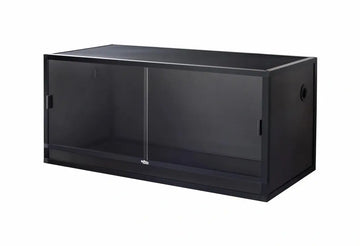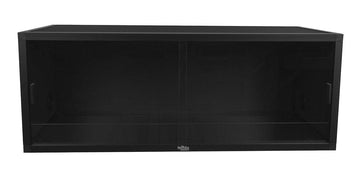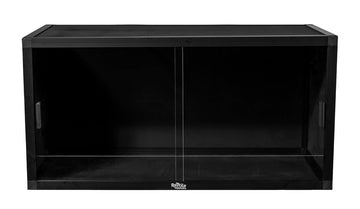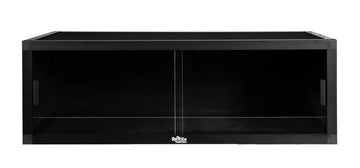Reticulated pythons (Malayopython reticulatus) are the longest snakes in the world. They are native to southeast Asia, but have spread to other parts of the world as an invasive species. Reticulated pythons can live in a variety of different habitats, but they generally prefer forests and wetlands. Although categorized as “terrestrial,” retics are known to be skilled at both climbing and swimming.
Reticulated pythons are capable of growing up to 32’ long, but they usually stay between 15-20’. However, not all retics get even that long. Certain dwarf localities top out between 10-12’, and “super dwarfs” are restricted to 6-8’. They have an oblong head, visible heat pits around the snout, muscular body, and vertical pupils. Retics can be identified by their golden to brown base color with a black and orange zigzag pattern. They also usually have a thin dark stripe on each side of their head extending from the eye to the ear. However, captive breeding efforts have produced a variety of alternative colors and patterns.
Most people will see their first reticulated python in a zoo or during an educational presentation. While they can make striking animal ambassadors and zoo exhibits, they make very poor pets for all but the most dedicated and prepared keepers. Retics require a significant investment of time, space, and money to house and care for properly. Although most reptiles in the pet trade are quite harmless to humans, reticulated pythons are an exception: if the right precautions are not taken, even pet retics are quite capable of injuring and even killing their caretakers.
With good care, reticulated pythons can have a 30 year lifespan.
Minimum enclosure size for reticulated pythons
Many sources will tell you that an appropriate minimum enclosure size for one reticulated python is 8’L x 4’W x 4’H or less. This can work for a super dwarf or even dwarf retic, but this is too small for an up to 30’ long, full-sized reticulated python.
Due to the variation in reticulated pythons’ size, use this formula to determine the absolute minimum enclosure size for your pet: The length and width of the enclosure should be equal to or more than the length of the snake. Height should be as tall as possible to facilitate natural climbing behavior; at least 6’. A larger enclosure will always be better! The enclosure must also be completely sealed against the possibility of escape, from the door latch to the thickness of the glass.
To predict your pet’s adult size, it’s best to ask your snake’s breeder about the size of its parents. The sire’s length will give you an estimate of how long your pet will grow if male, and the dam’s length will give you an estimate of how long your pet will grow if female.
Cohabitation (keeping multiple reticulated pythons in one enclosure) is not recommended.
Do reticulated pythons need UVB?
Technically they can survive without it, but we still recommend providing appropriate UVB lighting for reticulated pythons. UVB lighting helps provide a clear day/night cycle, provides all of the vitamin D that your pet needs, strengthens the immune system, facilitates better digestion, and provides other benefits.
The best UVB bulbs for reticulated pythons vary based on the distance between the bulb and the snake’s back on the basking surface:
- Zoo Med Reptisun T5 HO 5.0
- Mesh obstruction: 11-13”
- No mesh: 14-16”
- Arcadia Forest 6%
- Mesh obstruction: 11-13”
- No mesh: 14-16”
- Zoo Med Reptisun T5 HO 10.0
- Mesh obstruction: 15-17”
- No mesh: 18-20”
- Arcadia Desert 12%
- Mesh obstruction: 15-17”
- No mesh: 18-20”
The bulb you buy should be approximately half the length of the enclosure. For best results, house the UVB bulbs in a reflective fixture from Arcadia or Vivarium Electronics. If you install multiple UVB bulbs in your enclosure, it is strongly advised to use a Solarmeter 6.5 to measure UVB output so you don’t accidentally “fry” your snake with UV radiation. Target a basking UVI of 2.0-3.0.
UVB bulbs experience reduced UVB output over time, so make sure to replace your bulb every 12 months to maintain optimum performance.
Lights should be on for about 13 hours/day during summer and 11 hours/day during winter. This replicates seasonal cycles and may promote healthier hormonal cycling in your snake.
Best temperature for reticulated pythons
Like other reptiles, reticulated pythons are cold-blooded, which means that they rely on external temperatures to manage their own body temperature and metabolism. A reptile’s enclosure should offer a range of temperatures to allow them to thermoregulate effectively.
Specifically speaking, retics prefer an environment with a basking area temperature of 92-95°F, and a general air temperature between 82-90°F. Temperatures should drop to 72-78°F at night. Use wall-mounted digital thermometers to make sure your snake’s environment is always comfortable.
Provide heat for your snake with a cluster of enough halogen flood heat bulbs to evenly heat the snake’s entire body. Do not use colored bulbs or ceramic heat emitters, as these are not as effective. However, you may use radiant heat panels connected to thermostats to help maintain appropriate air temperatures during the day and night.
If your basking temps are too cool, you need higher-wattage heat bulbs. If your temps are too warm, use a multi-device dimming thermostat (automatic) or rheostat (manual) to reduce the bulbs’ output.
Best humidity levels for reticulated pythons
Reticulated pythons need average humidity levels between 65-85%. Humidity can be measured via outdoor hygrometer placed in the middle of the terrarium.
Increase humidity by misting your snake’s enclosure 1-2x/day with a garden pressure sprayer or automatic misting system. Mist first thing in the morning and then again at night. Alternatively, using a reptile humidifier connected to a hygrostat can be a helpful addition at night. There should also be a humid hide for your snake, lined with moistened sphagnum moss.
Soaking
Wild reticulated pythons are well-documented to routinely soak and swim, so make sure to provide a tub or pool of water at least large enough to accommodate their entire body. Keep the water clean at all times, and scrub with animal-safe disinfectant once a week. It’s a good idea to connect this pool to your home’s plumbing system to make this easier. Alternatively, you will need a pump or siphon. This pool should not be heated, and is a good way to provide the option of cooler temps to your snake.
Best substrate for reticulated pythons
Providing a thick layer of naturalistic substrate (“bedding”) will help cushion your reticulated python’s body, absorb waste, and also helps make your enclosure more attractive! We recommend the following substrates for reticulated pythons:
- Zoo Med Eco Earth
- Zoo Med ReptiSoil
- Exo Terra Plantation Soil
- Zilla Jungle Mix
Layering plenty of clean, chemical-free leaf litter on top of the substrate provides extra cover for your snake and also provides a good source of enrichment!
Substrate should be at least 4” deep and completely replaced every 3-4 months. Remove poop and urates daily, along with contaminated substrate. Any contaminated substrate that is removed should be replaced with fresh substrate. Expect to do this frequently, as reticulated pythons produce a lot of liquid urine.
How to decorate a reticulated python enclosure
An empty terrarium makes for a bored retic, reducing its quality of life. Keep your pet entertained and engaged with its environment with the strategic use of decor items that encourage it to exercise natural behaviors!
Since reticulated pythons are skilled climbers, it’s important to provide sturdy climbing objects to make use of the enclosure’s vertical space. You will also need to provide covered areas for the snake to hide as needed. Here are some other ideas:
- thick, sturdy branches or logs
- hides (dog kennels work well)
- ledges/platforms
- large live or artificial plants
Because reticulated pythons can be very heavy, make sure all branches, platforms, and other climbing objects are well secured to the walls and/or floor of the enclosure.
What to feed to a reticulated python
Reticulated pythons are carnivores, which means that they need to eat whole animal prey in order to get the right nutrition.
Reticulated pythons are notoriously overweight in captivity because they are frequently fed far more often than they actually need. Giant pythons actually thrive on infrequent, although large, meals. Here’s a proposed feeding schedule:
- Hatchlings — every 1-2 weeks
- Juveniles — every 2-4 weeks
- Adults — every 6-12 weeks
Once your snake reaches adulthood, let your snake’s body condition be your guide, not its behavior, as retics are almost always hungry! If the snake is getting thin, feed more often. If fat, feed less often.
One of the keys to great nutrition is variety, so it’s best to use as many different types of feeders in your snake’s diet as possible! Considerations include mice, rats, guinea pigs, rabbits, quail, chickens, and even piglets.
Prey items should be around 1.5x the snake’s width at its widest point. Although live prey can be offered, it’s best to use frozen whenever possible. Prey should be thawed in a BPA-free plastic bag in warm water until it reaches around 100°F, then use a pair of soft-tipped feeding tweezers to offer it to your snake.
Make sure another person is in the room during feeding in case the snake accidentally bites you instead of the food. In fact, as the snake gets larger, it’s a good idea to train it to take prey slowly and gently rather than quickly and aggressively.
Supplements
Reticulated pythons can survive without supplementation, but using them every once in a while can help prevent your snake from developing a nutritional deficiency, helping it live healthier. We recommend Repashy Calcium Plus LoD, lightly dusted on the prey item before offering.
How to handle your reticulated python
Reptiles generally don’t appreciate petting and handling in the same way that dogs and cats do. Retics can become wonderfully tame, but as large, strong animals, it’s important to acknowledge that they are capable of injuring and even killing a human if mishandled.
Here are some tips for success:
- Wait at least 2 weeks before attempting to handle your new snake.
- When picking up your snake, be gentle and try to pick it up from the side or below rather than from above.
- Support as much of its body as possible.
- NEVER pick it up by its tail, as this can damage its spine!
- Whenever possible, let the snake climb onto you rather than grabbing it.
- Keep handling sessions short at first.
- End handling sessions with the snake acting calm before putting it back.
- ALWAYS keep at least one other person in the room during handling sessions.
- Never let the snake free-roam unsupervised.
- Never handle in the same room as other pets.
*This care sheet contains only very basic information. Although it’s a good introduction, please further your research with high-quality sources. The more you know, the better you will be able to care for your pet!
"Malayopython reticulatus" by tristanv is licensed under CC BY-NC 4.0.











